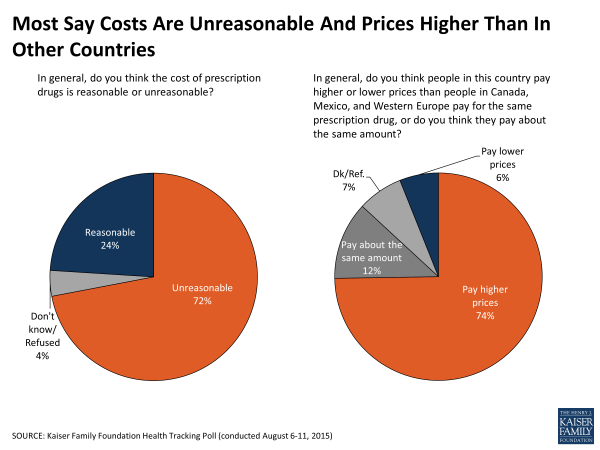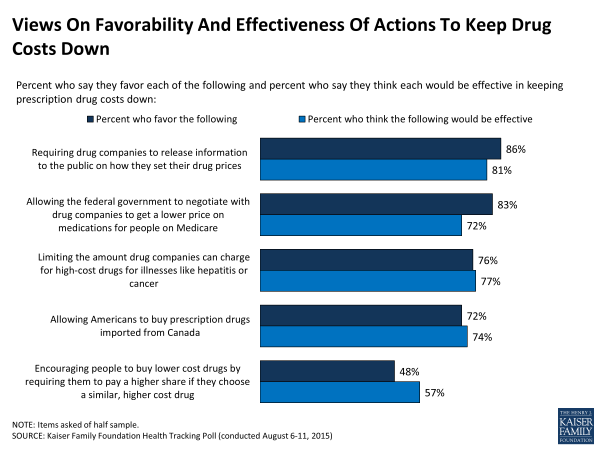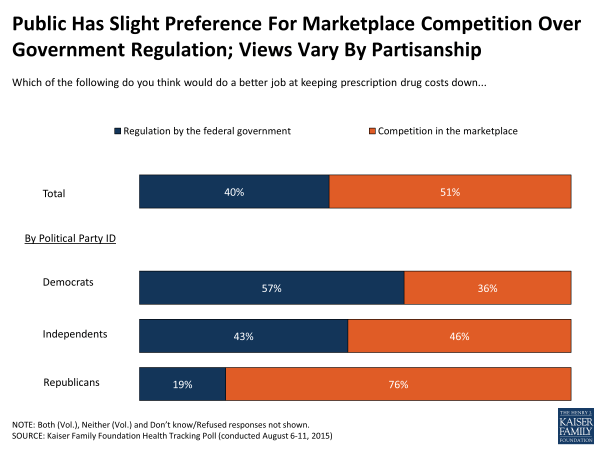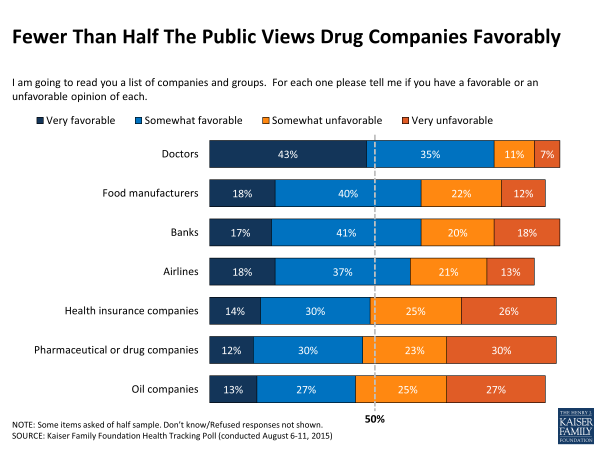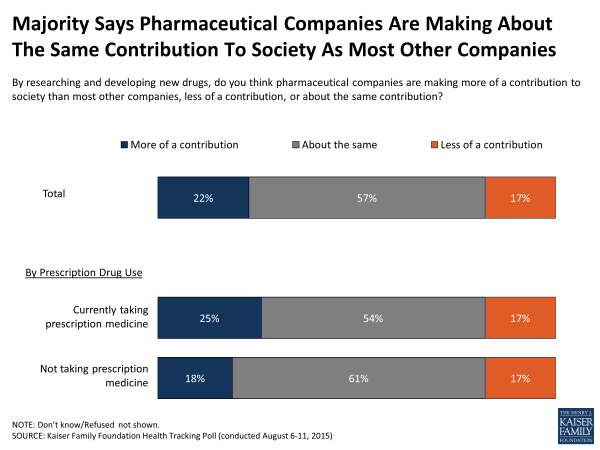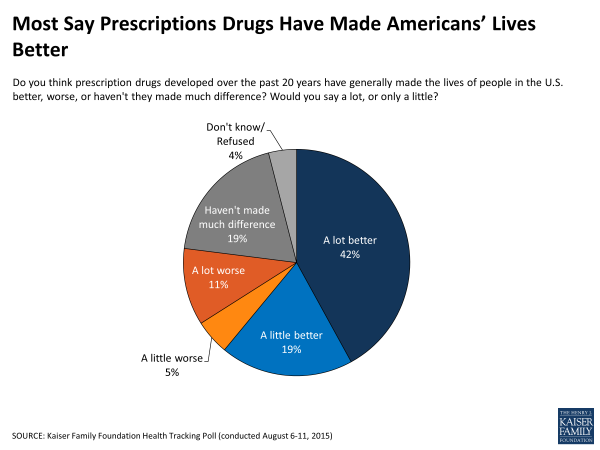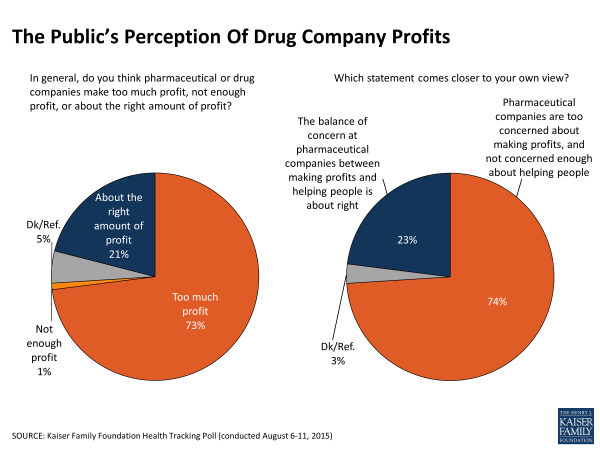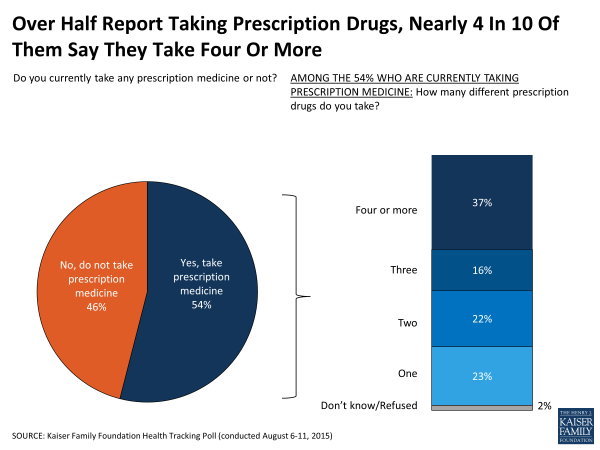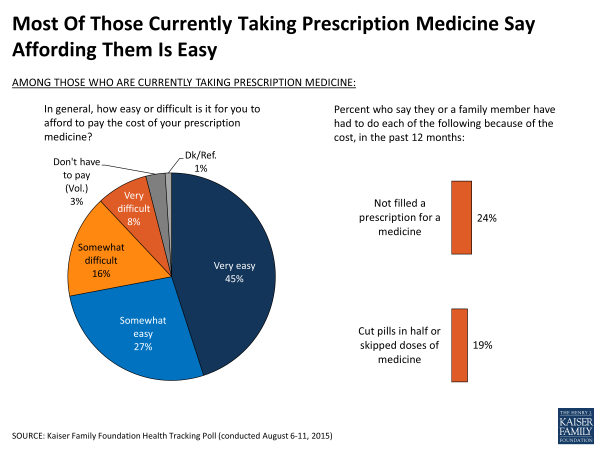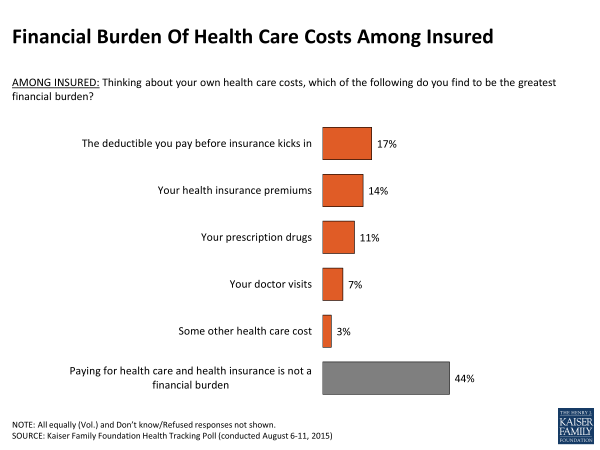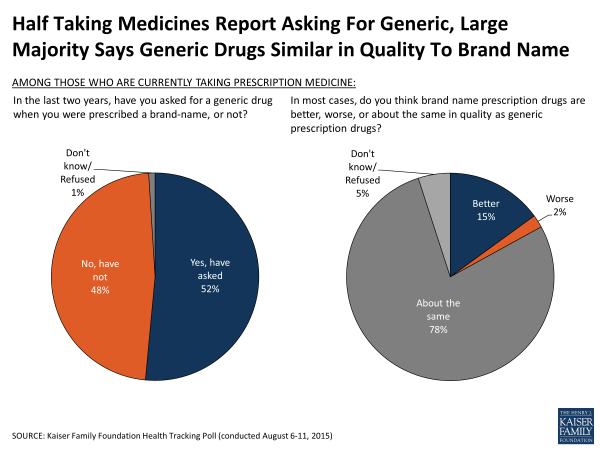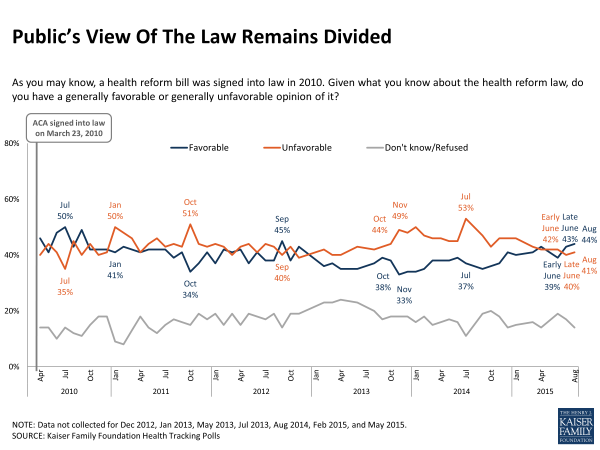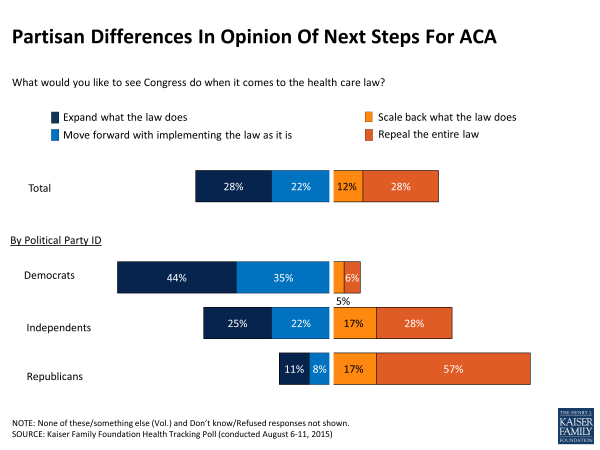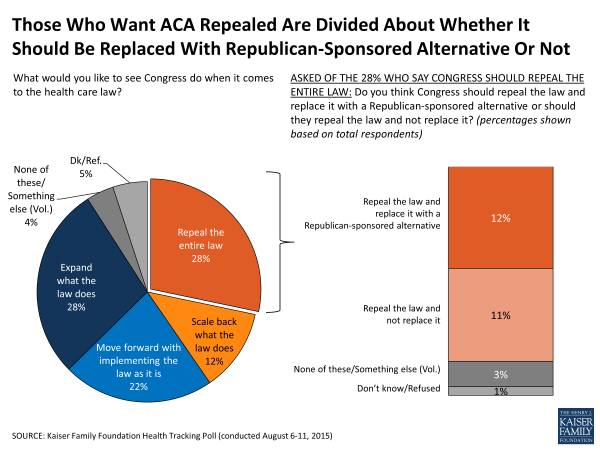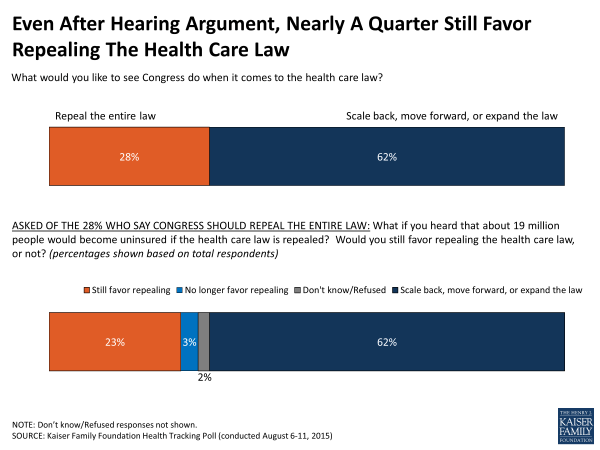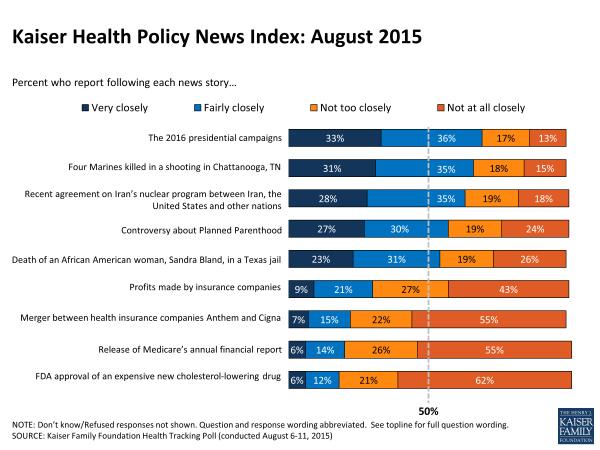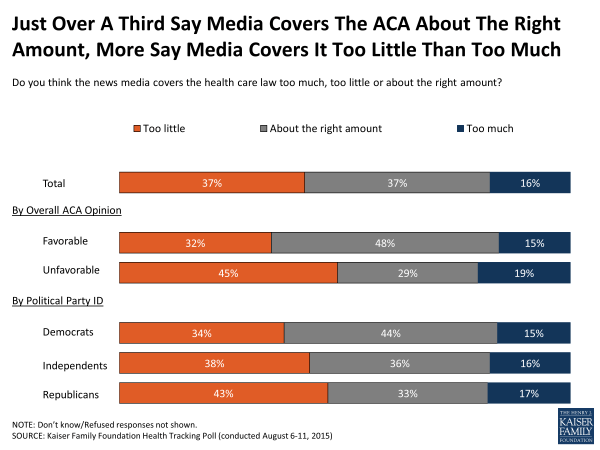Kaiser Health Tracking Poll: August 2015
With renewed discussion of the high cost of prescription drugs recently, the August Kaiser Health Tracking poll finds that most Americans feel that drug costs are unreasonable (72 percent) and that drug companies put profits before people (74 percent). At the same time, the public largely values the role prescription drug companies play, with most (62 percent) saying that prescription drugs developed in the past two decades have made the lives of people in the U.S. better, including about 4 in 10 (42 percent) who say a lot better. About half of Americans (54 percent) report currently taking prescription drugs, with most of them (72 percent) saying they are easy to afford, while about a quarter (24 percent) say they have a difficult time paying for their drugs; a share that rises among those with lower incomes (33 percent) or in worse health (43 percent). Large shares, across the partisan spectrum, have favorable views of several proposed actions to lower drug costs, including requiring drug companies to release information to the public on how they set their drug prices (86 percent) and allowing the federal government to negotiate with drug companies to get a lower price on medications for people on Medicare (83 percent), and majorities also say these strategies would be effective. Reflective in part of the perceived high costs of prescription drugs and focus on profits, about 4 in 10 (42 percent) Americans have a favorable view of drug companies, lower than the shares who feel favorably towards doctors (78 percent), food manufacturers (58 percent) and banks (58 percent).
When it comes to their views of the Affordable Care Act (ACA) this month, the American public remains divided in their opinion of the law; 44 percent say they have a favorable view and 41 percent say they have an unfavorable view. Nearly 3 in 10 (28 percent) say they want Congress to expand what the law does, an identical share (28 percent) want the law repealed, and the remainder fall in the middle by saying they want Congress to continue implementing the law as it is (22 percent) or scale it back (12 percent). Those who favor repeal are divided on whether the law should be replaced with a Republican-sponsored alternative or if it should be repealed and not replaced (12 percent and 11 percent of the public overall). In addition, even after being told that about 19 million people would become uninsured if the health care law were to be repealed, only 3 percent are swayed to say they no longer favor repealing the law.
The Public’s Views On Prescription Drugs
Most Say Costs Are Unreasonable And Higher Than In Other Countries
Due to a renewed focus on the issue of prescription drug costs amongst policymakers and the media, the August Kaiser Health Tracking Poll expands upon the April and June Kaiser Health Tracking Polls that touched on the issue. As in June, this month a large majority of the public (72 percent) view the cost of prescription drugs as unreasonable. Those currently taking prescription drugs are somewhat more likely to say drug costs are unreasonable (77 percent), but still 66 percent of those not currently taking medications say they are unreasonable. In addition, about three quarters of the public (74 percent) think people in the U.S. pay higher prices than people in Canada, Mexico and Western Europe pay for the same prescription drug, a share that is similar across those taking medications and those who are not.
Views On Ways To Keep Drug Costs Down
Public Is Favorable Toward A Number Of Proposed Ways To Keep Drug Costs Down
When presented with policy options intended to help keep the cost of prescription drugs down, the public is supportive of a number of different actions and a majority feels each would be an effective option. Topping the list is requiring drug companies to release information to the public on how they set their drug prices, with more than 8 in 10 Americans reporting a favorable view (86 percent) and saying it would be effective (81 percent). Eight in 10 (83 percent) also favorably view allowing the federal government to negotiate with drug companies to get a lower price on medications for people on Medicare, while 72 percent view this as effective. In addition, more than 7 in 10 favor limiting the amount drug companies can charge for high-cost drugs for illnesses like hepatitis or cancer (76 percent) and allowing Americans to buy prescription drugs imported from Canada (72 percent) and similar shares think these would be effective actions to help lower drug prices (77 percent and 74 percent, respectively). Lower on the list is encouraging people to buy lower cost drugs by requiring them to pay a higher share of the cost if they choose a similar, but higher cost version of the drug (48 percent favorable). However, even more (57 percent) say this would be effective.
Feelings about these options and their effectiveness are similar across parties with the exception of allowing the government to negotiate on Medicare drugs which is favored by a somewhat higher share of Democrats (93 percent) than Republicans (74 percent) or independents (83 percent) and where more Democrats feel it would be effective (88 percent) than Republicans (56 percent) or independents (74 percent).
| Table 1: Views Of Policy Actions To Keep Drug Costs Down By Party Identification | |||
| Percent who say they favor each of the following and percent who say they think each would be effective in keeping prescription drug costs down: | Party ID | ||
| Democrats | Independents | Republicans | |
| Requiring drug companies to release information to the public on how they set their drug prices | |||
| Favorable | 90% | 84% | 82% |
| Effective | 83% | 85% | 75% |
| Allowing the federal government to negotiate with drug companies to get a lower price on medications for people on Medicare | |||
| Favorable | 93% | 83% | 74% |
| Effective | 88% | 74% | 56% |
| Limiting the amount drug companies can charge for high-cost drugs for illnesses like hepatitis or cancer | |||
| Favorable | 79% | 77% | 70% |
| Effective | 82% | 78% | 74% |
| Allowing Americans to buy prescription drugs imported from Canada | |||
| Favorable | 69% | 76% | 75% |
| Effective | 72% | 78% | 71% |
| Encouraging people to buy lower cost drugs by requiring them to pay a higher share if they choose a similar, higher cost drug | |||
| Favorable | 51% | 47% | 51% |
| Effective | 56% | 59% | 60% |
| Note: Items asked of half samples. | |||
Partisan Disagreement On Government Regulation Or Marketplace Approach
When asked whether regulation by the federal government or competition in the marketplace would do a better job at keeping prescription drug costs down, more prefer competition in the marketplace than government regulation (51 percent vs. 40 percent). Not surprisingly, a majority of Democrats (57 percent) feel regulation would do a better job, while about three quarters of Republicans (76 percent) feel market competition is better. Independents are divided with 43 percent saying regulation and 46 percent saying market competition.
Opinion Of Pharmaceutical Companies
Majorities of the public feel favorably towards a number of companies and groups in American society, such as doctors (78 percent), food manufacturers (58 percent), banks (58 percent), and airlines (55 percent), but pharmaceutical companies rank lower. About 4 in 10 (42 percent) of the public views pharmaceutical companies favorably, similar to the shares who have positive views of oil companies (40 percent) and health insurance companies (44 percent). The share with favorable views of pharmaceutical companies is similar across Democrats (38 percent), Republicans (41 percent) and independents (42 percent).
While Americans hold some other industries and groups in higher regard than pharmaceutical companies, most of the public (57 percent) says drug companies are making about the same contribution to society as most other companies. About a fifth (22 percent) say they are making more of a contribution to society than most other companies and just under a fifth (17 percent) say they are making less of a contribution. Those who are currently taking prescription drugs are somewhat more likely than those not taking prescription drugs to say drug companies are making more of a contribution to society than other companies (25 percent vs. 18 percent).
Most Feel Drugs Have Improved Americans’ Lives
Most of the public (62 percent) says that prescription drugs developed in the past 20 years have made lives of people in the U.S. better, including 4 in 10 (42 percent) who say a lot better, while about 15 percent say they have made the lives of people in the U.S. worse and 19 percent say they haven’t made much difference.
Many Say Drug Companies Are Focused Too Much On Profits
While many feel pharmaceuticals have improved Americans’ lives, over 7 in 10 Americans (73 percent) say drug companies make too much profit, while about 2 in 10 (21 percent) say they make about the right amount of profit and very few say they do not make enough profit (1 percent). Those who feel the cost of prescription drugs is unreasonable are much more likely to say companies make too much profit than those who say costs are reasonable (83 percent vs. 46 percent).
In addition, about three quarters of the public (74 percent) say that pharmaceutical companies are too concerned about making profits and not concerned enough about helping people, while about a quarter (23 percent) say the balance between making profits and helping people at drug companies is about right. Again, those who believe drug costs are unreasonable are more likely to say drug companies are too concerned with making profits than those who feel drug costs are more reasonable (82 percent vs. 52 percent).
Personal Experience With Prescription Drugs
The cost of prescription drugs is personal for many as just over half of Americans (54 percent) report currently taking any prescription medicine, many of whom (37 percent of those currently taking drugs) report taking four or more different prescription drugs.
About 7 in 10 (72 percent) of those taking drugs say they are very or somewhat easy to afford, but about a quarter (24 percent) report that affording their prescription medicine is difficult, a share that rises to 33 percent of those with lower incomes (household incomes less than $40,000) who currently take prescription drugs. Some taking prescription drugs also report that in the past year they or a family member have not filled a prescription (24 percent) or skipped a dose or cut pills in half (19 percent) because of the cost.
Those who report that they are in fair or poor health and those who say they are currently taking 4 or more prescription drugs are more likely than their counterparts to say affording their medicine is difficult (43 percent vs. 17 percent and 38 percent vs. 16 percent, respectively). These groups are also more likely than others to say that they have not filled a prescription or cut pills in half or skipped doses in the past 12 months due to cost (Table 2).
| Table 2: Those In Worse Health Or Taking 4 Or More Drugs More Likely To Report Difficultly Affording Their Medicines | ||||
| Health Status Among Those Taking Prescription Drugs | Prescription Drug Use | |||
| Excellent/ Very Good/ Good Health |
Fair/ Poor Health | Taking 1-3 Prescription Drugs |
Taking 4 Or More Prescription Drugs |
|
| In general, how easy or difficult is it for you to afford to pay the cost of your prescription medicine? | ||||
| Very easy | 54% | 18% | 53% | 32% |
| Somewhat easy | 26 | 32 | 27 | 27 |
| Somewhat difficult | 12 | 28 | 12 | 24 |
| Very difficult | 5 | 15 | 4 | 14 |
| In the past 12 months, have you or another family member living in your household not filled a prescription for a medicine? | ||||
| Yes | 19 | 37 | 21 | 30 |
| No | 80 | 63 | 79 | 69 |
| In the past 12 months, have you or another family member living in your household cut pills in half or skipped doses of medicine? | ||||
| Yes | 15 | 31 | 14 | 27 |
| No | 85 | 68 | 86 | 72 |
| NOTE: Don’t know/ Refused responses not show. “Don’t have to pay (Vol.)” responses not shown. | ||||
Among those with insurance, prescription drug costs rank among a number of other health expenses, with 11 percent saying their prescription drug costs is their most burdensome health care cost, while 17 percent say it is the deductible, 14 percent say it’s their health insurance premiums, and 44 percent say that paying for health care and health insurance is not a financial burden. For those with lower incomes, paying for prescription drugs tops the list, with 17 percent reporting it is their greatest financial burden when it comes to health care costs.
Using generic over brand-name prescription drugs is one way to spend less on the cost of prescription drugs and just over half (52 percent) of those who say they are currently taking prescription medicine say that in the past two years they have asked for a generic drug when they were prescribed a brand-name. About 8 in 10 (78 percent) of those currently taking prescription drugs say brand-name drugs are about the same in quality as generic drugs, and 15 percent say they are better in quality, while just 2 percent say they are worse.
Views Of The Affordable Care Act
Public Still Split In Opinion Of Health Care Law
Consistent with findings over the past few months, the American public remains divided in their opinion of the health care law; 44 percent say they have a favorable view and 41 percent say they have an unfavorable view. Opinion of the law continues to diverge along party lines, with most Democrats reporting a favorable view of the law (76 percent) and most Republicans reporting an unfavorable view of the law (71 percent). Among independents, 46 percent say they have an unfavorable view, while 39 percent report a favorable view.
Next Steps For The ACA
Opinion about what Congress should do next when it comes to the law also has been fairly constant over time. Nearly 3 in 10 (28 percent) say they want Congress to expand what the law does, an identical share (28 percent) hope for a complete repeal of the law, and the remainder fall in the middle by saying they want Congress to continue implementing the law as it is (22 percent) or scale it back (12 percent).
Those who want Congress to repeal the law in its entirety are split about what should happen next. Twelve percent say they think Congress should replace the law with a Republican-sponsored alternative, while 11 percent say they would like the law repealed and not replaced.
Although those who want the law repealed disagree about what Congress should do, they are unified in their unwavering desire for repeal. After being told that about 19 million people would become uninsured if the health care law were to be repealed, only 3 percent are swayed to say they no longer favor repealing the law.
However, the vast majority of the public (70 percent) does not think that the Republicans in Congress have an agreed-upon alternative. Even majorities of those who would like to see it repealed and replaced with a Republican-sponsored alternative (58 percent) do not think that that such an alternative exists.
Kaiser Health Policy News Index: August 2015
The Kaiser Health Policy News Index is designed to help journalists and policymakers understand which health policy-related news stories Americans are paying attention to, and what the public understands about health policy issues covered in the news.
In the wake of the first Republican primary debate that took place the first week of August and the first night this survey was in the field, nearly 7 in 10 Americans report “very” or “fairly” closely following news coverage of the 2016 presidential campaigns (69 percent), significantly more than the slim majority that said the same in the last two Kaiser Health Policy New Index reports. Perhaps not surprisingly given the recent debate, Republicans (78 percent) are more likely to say they have been following the presidential campaigns closely than Democrats (71 percent) or independents (66 percent). About two thirds of the public (66 percent) report following another national headline, coverage of the four Marines killed in a shooting in Chattanooga, Tennessee, as well as the international headline about the recent agreement on Iran’s nuclear program between Iran, the United States, and other nations (63 percent). More than half followed other national news stories such as the controversy about Planned Parenthood (57 percent) and the death of an African American woman, Sandra Bland, in a Texas jail (54 percent).
Health stories fall to the bottom of the public’s radar this month, with just 3 in 10 (30 percent) saying they closely followed profits made by insurance companies, and about 2 in 10 say they closely followed the merger between health insurance companies Anthem and Cigna (22 percent), the release of Medicare’s annual financial report (20 percent), or the Food and Drug Administration’s (FDA) approval of an expensive new cholesterol-lowering drug (18 percent). Those who say they are currently taking prescription medicine are slightly more likely to say they followed news of the FDA’s approval of the new cholesterol-lowering drug closely than those who say they are not taking any prescription drugs, however these shares are small among both groups (21 percent vs. 13 percent, respectively).
The Health Care Law In The Media
Although more than 4 in 10 of the American public have previously said that they are tired of hearing about the health care law and are ready for the country to focus on other issues,1 this month, the public doesn’t express fatigue with the topic. When asked about news coverage of the health care law, just 16 percent say they think the news media covers the health care law too much, while 4 in 10 say it covers the law too little (37 percent) or about the right amount (37 percent). This is a rare instance where there is no large difference by political party, however opinion does vary by favorability towards the health care law. Those with an unfavorable view are more likely than those with a favorable view to say the media covers the law too little (45 percent vs. 32 percent), while those with a favorable view are more likely than those with an unfavorable view to say the media coverage is about right (48 percent vs. 29 percent).

